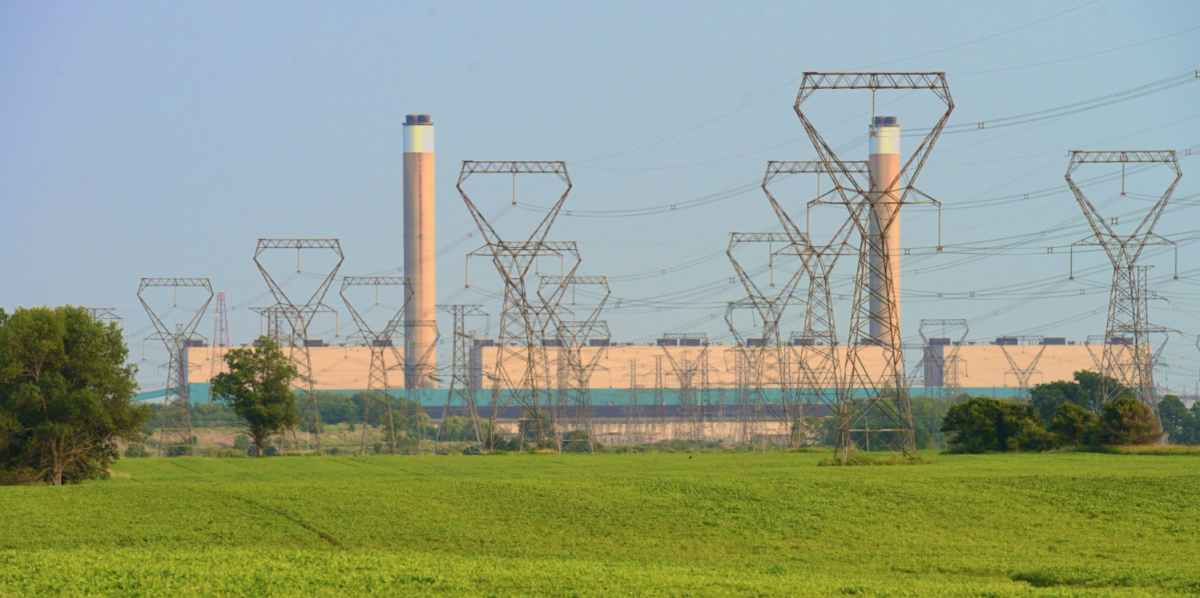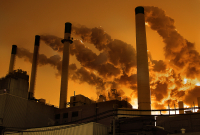Support strong Canadian climate journalism for 2025
The Ontario government is fiercely disputing the validity of a recent Fraser Institute report claiming that phasing out coal-fired power plants across the province yielded only “small improvements” in air quality between Ottawa, Hamilton, and Toronto.
Scientists from the Ministry of Environment and Climate Change (MOECC) allege that the models used by the right-wing think tank are “overly simplistic” and too “scientifically and methodologically flawed” to support the conclusions published in its January report, Did the Coal Phase-out Reduce Ontario Air Pollution?
Non-government scientists support the government's criticism of the Fraser Institute report.
And Bruce Lourie, president of the Ivey Foundation and a director of the Ontario Power Authority, classified it as “one more poorly-written report that’s aimed at attacking anyone that’s trying to make the environment healthier for Canadians.”
The report analyzed data for three Ontario cities between 2002 and 2014 (coal-fired power plants were phased out between 2005 and 2014) and used statistical models to determine that overall, the reduction of air contaminants associated with declining coal use was “statistically insignificant.”
Provincial government researchers, however, say that the Fraser Institute omitted key air contaminant variables in its study, used inappropriate analytical methods, and would not pass a peer review process.
“The authors’ analysis does not consider the spatial and temporal variability of the parameters considered,” said an email statement from MOECC. “There are also no justifications for all the interpolations and manipulations that the authors have applied to their input variables as part of their assessment.”
The Fraser Institute has wholeheartedly denied claims that it failed to account for key air contaminants, and in an email statement, pointed to the page numbers of its report that it claims address the scientists’ concerns.
Fraser Institute defends its science
“I suspect the scientists you talked to didn't read the report,” its co-author, Ross McKitrick, told National Observer. “Second, they need to explain why our results mirror so closely the predictions made by the province's own DSS report in 2005, on which the cabinet based its decision (to phase out coal-fired power plants).”
McKitrick, a University of Guelph economics professor, referred to a 2005 cost-benefit analysis on replacing Ontario’s coal-fired electricity prepared for the provincial government by DSS Management Consultants Inc. and RDWI Air Inc.. It predicted that closing the Lambton, Ont. and Nanticoke, Ont. power plants would have very small effects on the air concentrations of two contaminants, particulate matter (PM10) and ground-level ozone (O3).
“In fact, we argue that the reductions were probably somewhat larger than that report projected,” said McKitrick, a senior fellow of the Fraser Institute. “I guess the scientists you are referring to would say the DSS report would not have passed peer review either. Perhaps, but the province has relied on it ever since to justify its decision.”
Despite McKitrick's assertions, the Ontario government's criticism of the Fraser Institute report is backed by a team at the Canadian Energy Research Institute (CERI) and an engineering professor at the Energy and Emissions Research Lab at Carleton University. The Fraser Institute study’s modeling was not predictive enough to claim that the phase-out had a negligible impact on air pollution, they both said in separate statements.

Same report, different conclusions
The Fraser Institute is known for sharp critiques of clean energy policies. Since 2008, the research organization has received more than $500,000 in funding from the billionaire American Koch brothers, whose affiliates have poured more than US$88 million into groups that have seeded doubt on climate change science since the late nineties.
In its report on the Ontario coal phase-out, the Fraser Institute asserts the government shuttered the plants to save $3 billion in annual health care costs.This was indeed, one of the province’s widely-cited reasons for closing down the plants, as was the need to reduce greenhouse gas emissions in dealing with the threat of climate change.
The report however, makes little mention of this second motivation. After it was published, McKitrick penned a commentary piece in the Financial Post claiming Ontario's entire coal phase-out plan has been "for nothing," and calling climate change a “red herring” in a discussion of costs and benefits associated coal reduction.
Since 2003 however, Ontario’s coal plan has eliminated more than 30 megatonnes of annual emissions (the equivalent of taking seven million vehicles off the road), and today, more than 90 per cent of the power generated in Ontario comes from clean energy sources. According to the Ontario government, the plan also helped reduce the number of smog days in Ontario from 53 in 2005 to zero in 2015; and last year, avoid more than 150,000 tonnes of smog-causing pollutants; and eliminate the release of 320 kilograms of mercury to air annually.
Sulphate and nitrate particulates, said the MOECC, decreased by as much as 77 per cent and 75 per cent, respectively, from 2007 to 2010 at several sites across the province — a decrease partially attributed to reduced emissions of SO2 and NOx from coal-fired power plants.
The government's conclusion that the Fraser Institute report was flawed is supported by outside scientist.
“The Fraser Institute report is a fairly simple, high-level analysis of a complex system, where they are attempting to analyze selected data for Ontario in isolation,” said Matthew Johnson, a research professor for Carleton University’s Energy and Emissions Research Lab, in an email. “A better approach might be to ask, how do today’s pollutant concentrations compare with what they would have been had the plants not been closed?”
Not considered in the report, he argued, are sulphur oxides (SOx), mercury, greenhouse gas emissions or reported smog days. Changing pollution levels from other non-coal sources, like vehicles, he added, or those wafting in from beyond Ontario were also not adequately distinguished or accounted for.
Allan Fogwill, president and CEO of the Calgary-based CERI and an energy sector executive with more than 25 years of experience, agreed.
“It’s very difficult to isolate — in fact, I would say it’s impossible — to isolate the impacts of coal NOx (nitrogen oxides) based on their model,” he told National Observer. “In our experience, the models are not predictive enough to make the conclusions that they’ve made.”
In response, McKitrick of the Fraser Institute argued that greenhouse gas emissions “are not part of the smog issue,” and that the report’s focus on air quality alone is due to the government’s emphasis on the topic as a rationale for closing the plants. Greenhouse gas reductions, the report claimed, can be achieved not only by plant shutdown but also by purchasing carbon offsets. In a previous report published in 2013, McKitrick concluded there were much cheaper ways to achieve environmental goals than phasing out coal,such as installing scrubbers on the smokestacks.
“I have written about the GHG issue elsewhere,” he said in an email. “Indirect measures like numbers of cars and even numbers of smog days are less informative than just using the direct measurements on the specific variables we are interested in.”
Implications for Alberta
None of the scientists from CERI or the Ontario government would speculate as to why the Fraser Institute chose to focus on the variables it did. But Lourie, the Ontario Power Authority director, said the think tank has a long history of suggesting environmental regulation are a bad thing.
“The report is making it sound like coal is a viable future source of electricity and I think that’s clearly not the case if you look at the evidence of coal use globally,” Lourie, the Ontario Power Authority director, told National Observer. “The Fraser Institute has a long history of writing reports that suggest environmental regulations are a bad thing… and I think what we saw in Ontario was very early leadership. I think you have to recognize that there are costs to being first and taking that kind of a leadership position.”
Many of the coal plants that were phased out, he added, were already beyond their scheduled lifespan — a tidbit the report left out. The real question for the Ontario government, Lourie explained, was what to replace them with.
As McKitrick noted in his Financial Post column, the conversation about the benefits of phasing out Ontario’s coal plants comes at a critical time: the federal government plans to phase out coal-fired electricity by 2030 for many of the same reasons Ontario did, and Alberta too, has committed to closing plants by 2030.
In the report co-authored by Fraser Institute senior economist Elmira Aliakbari, he argues that coal power is an even smaller relative emissions source in Alberta than it was in Ontario, and therefore, “it is reasonable to suppose that its phase-out will have equally small impacts on Alberta air quality.” Just over half of Alberta’s electricity is generated by coal.
Johnson from Carleton University put the think tank's claims in check: he said reductions in air pollution in Alberta “may well be greater” than what was achieved in Ontario, and Alberta plants may be "dirtier" on average by comparison.
“A much higher proportion of Alberta’s air quality is dictated by local sources in Alberta (unlike Ontario which is heavily influenced by pollutant transport from the U.S.),” he explained. “Thus local reductions in Alberta pollution could be expected to have even more direct benefit locally.”
According to legislation introduced by the Harper government, Alberta’s existing coal plants would have been phased out by 2030 or they would have had to introduce carbon capture and storage technology to reduce emissions.
The Canadian Association of Physicians for the Environment estimated that in 2008, air pollution from the province’s coal plants led to 107 premature deaths, 80 hospital admissions for respiratory and cardiovascular ailments from short-term exposure, and 700 emergency room visits.






Comments
Why anyone pays any attention to reports from the Fraser Institute is beyond me. They are a right wing advocacy group with a clear agenda and have never let science or fact interfere with their messaging. Fake News? your name is Fraser institute.
How can anyone give credence to an outfit that takes money from the Koch brothers? For those not familiar with the nefarious brothers I recommend the book "Dark Money" by Jane Mayer. It documents their disdain for democracy, the people that work for them, and the population that has to breath the air they contaminate.
Pollution from coal-fired power plants have been reduced over the years due to the closing of those plants in Ontario and the U.S., and the substitution of coal by natural gas in many U.S. power plants (unfortunately, that natural gas comes from fracking operations which according to many studies is as worse a burning coal because of its methane leaks impact on climate change). In Toronto particularly, the impact of closing those coal-fired plants on the level of pollution has been significant. The transportation sector is actually the main producer of GHG emissions in the greater Toronto Area. A recent report by the National Energy Board (NEB) shows that the largest source of transportation emissions in Canada is from "passenger" transportation, which reached 95 megatons (Mt) in 2014 (total emissions from the transportation sector were 171 Mt in 2014). The report also shows that "despite improved fuel economy and emissions standards" in most vehicles, the growing trend of "consumer preference" for SUV's and light trucks has resulted in GHG emissions from light trucks more than doubling, from 22 megatons (CO2 eq.) in 1990 to more than 50 Mt in 2014, which according to the NEB has "more than offset" reductions in passenger car emissions from 52 Mt in 1990 to 36 Mt in 2014 (source: NEB Market Snapshot, July 14, 2016: "Increased GHG emissions from the transportation sector reflect major consumer and business trends").
One way to fix that problem is to invest massively in public transportation. To finance those investments, governments should hike taxes on gasoline which will reduce the demand for gas guzzling vehicles. It worked before, it should work again because financial incentives seems to be the only vehicle that's forcing people to change their behaviour (years of environmental awareness and education didn't work).
The Frazer Institute is not a 'think' tank.....these folks don't have to think...they know. Been around for years, having their behinds licked by mainstream media not much interested in thinking............or the scientific research method either. Follow the money. They are financed by the Koch's and other oil and ges cartels...and here's what the creeps do.
THEY DECIDE WHAT THEIR IDEOLOGY WANTS TO PROVE....SET UP THEIR CONCLUSIONS, AND THEN GO IN SEARCH OF THE BITS OF DATA THAT COBBLED TOGETHER, MAKE IT LOOK LIKE THEIR IDEOLOGY HAS TRIUMPHED AGAIN.
But at this juncture in our history, they are climate criminals...more in need of jail time than the tobacco mogols who played the same game years ago....they are willing to let ideology destroy life on earth...calculating, with their typical scientific spin, they they and their's will be dead, or in safe gated communities, when the trouble starting all over the planet now, hits catastrophic proportions.
That fanatics bomb abortion clinics while leaving these junk research hirelings to spread their garbage, says sad things about we, the people. Follow the money, do a peer review, and shut them down. Astro turf at its most corrupt.
Propaganda-tank is more like it.
TFI can best "defend the science" in its report by submitting it to a peer-reviewed journal for publication. If it makes it in, I'll read it.